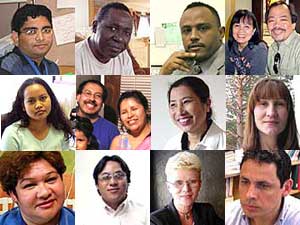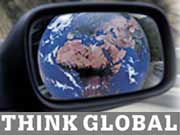May 16, 2005
 |
| Faces of Minnesotans who have moved here from other countries. Increasingly, they are faces of color -- from Africa, Asia and Central America. (MPR photos) |
St. Paul, Minn. — Someone once said, when China sneezes, the world catches a cold.
You can play on that phrase any number of ways when you set out to create a portrait of Minnesota's global face.
When the Soviet Union broke up, or conflict broke out in the African countries of Somalia and Ethiopia, or inter-ethnic civil strife ripped apart Yugoslavia, Minnesota gained a new architect or a photographer or musician, a college professor.
And Minnesotans gain new neighbors, often people who are happy simply to be alive, and living in a place with a long history of extending a welcome and opportunity to people from other places.
Minnesota's global face is created from the ebb and flow of human events halfway around the world or as close as Mexico. It is not so European or white, as it once was.
Nineteenth century northern Europeans arriving in the U.S. by ship were the state's first immigrants. The 21st century immigrant arrives by plane from Somalia, Ethiopia, Thailand, Vietnam, Russia, Ecuador. Or by car or bus from Mexico or Canada.
They often arrive with little more than some clothes, photographs of home and dreams of a new life. They leave behind family and all the old familiar ways of home.
Some, like 43-year-old Marta Morales, first tried to find a new life in another U.S. city. Marta arrived here from Mexico by way of Los Angeles. She says even after four years living and working in Minneapolis, the Minnesota cold and snow are still a drag.
Marta speaks for all immigrants, when asked what she misses about home.
"The streets, food, my family," she says.
The state demographic center estimates there are 175,000 Latinos living in Minnesota, the state's biggest immigrant group. Hmong refugees are second in size to Latinos. The estimate of 60,000 Laotion Hmong is probably bigger now, with the arrival of some 3,000 new Hmong from a refugee camp in Thailand beginning last summer.
Abdirahan Adan and his family fled Mogadishu when civil war broke out in Somalia in 1990. He arrived here in 1995, when he turned 15. Today, he's a student at the U of M. He still remembers the two weeks it took his family to escape the violence in his hometown.
"I never imagined to be away from my country or leave Somalia, and I bet that's how all Somalis feel," Abdirahan says. "The war happened and you have to do whatever you can."
In 2003, Somalia was the leading country of origin for Minnesota immigrants and today, there are an estimated 25,000 Somalis living here. India, Ethiopia, Philippines, Mexico and the People's Republic of China round out the top five countries of origin.
Europeans, many from the former Soviet Union, still make up a significant portion of Minnesota's growing immigrant population. Romana Vasylevych is from Ukraine. She grew up in the USSR and came to Minnesota seven years ago this month.
A professional musician, Romana plays the bandura, a harp-like instrument with 64 strings, and works at Kramarzcuk's restaurant in northeast Minneapolis.
"Before I came here, I was twice in the United States and loved so much this country," she says.
Like many immigrants, she wants to become a U.S. citizen.
If you want to know more about the bandura or Ukraine, you can stop in Kramarzcuk's and ask for Romana. Or click on the interactive map to learn about her, and all the other people who make up the global face of Minnesota.




